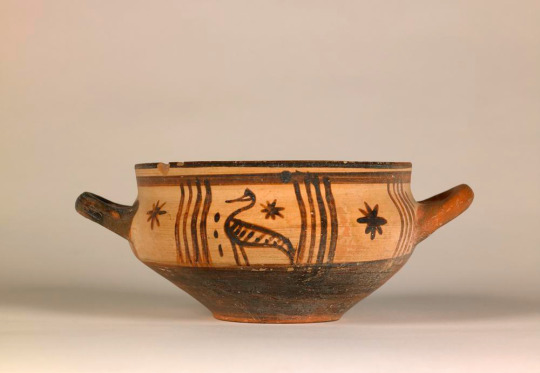#skyphoi
Photo
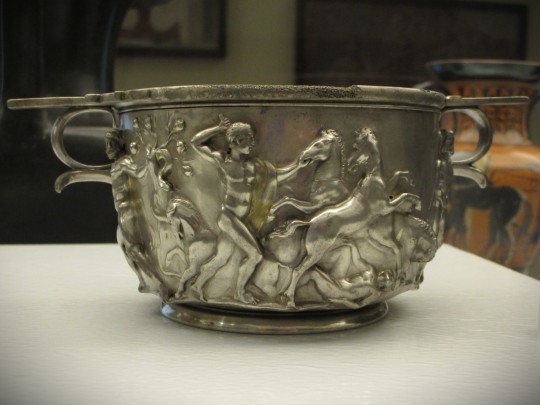
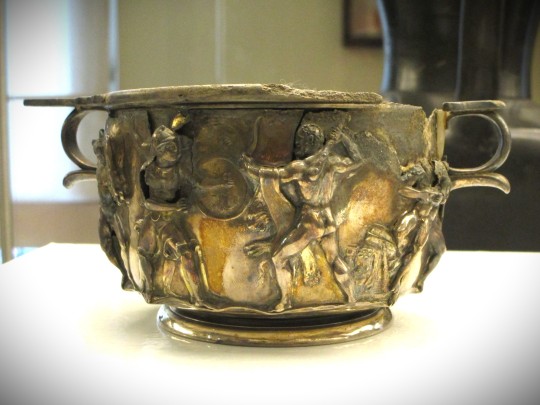
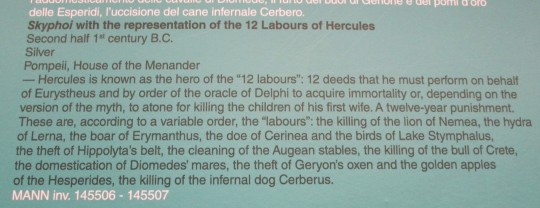
Two-handled silver wine cup decorated with Hercules’ labors, excavated from the ruins of Pompei - National Archeological Museum, Naples
Photos by Charles Reeza
16 notes
·
View notes
Photo
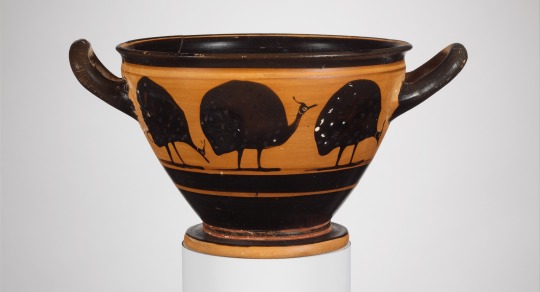

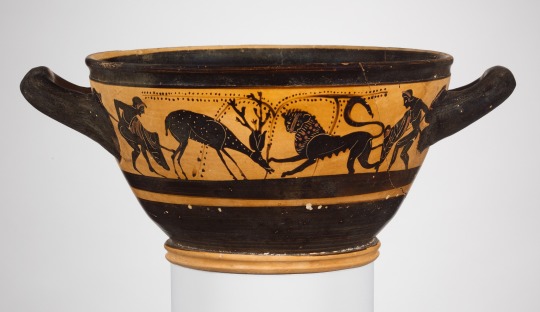
Terracotta Skyphoi (deep drinking cups)
- circa 500 BC - From Greece, Attic -
- Adorned with waterfowl -
- Adorned with wolves -
- Adorned with a lion and a deer -
8 notes
·
View notes
Text
Nalgas morenas gay
Massage Therapy of Needles, Legs and Lower Back ASMR
brisbane casino development
Sexy virgin Zenya Lai plays with her pussy before sucking and taking cock for first time
The Best Mercy Hentai Video
Novinha libanesa safada com pepino na buceta
Chinese nasty hardcore deep sex
Hot Milf Teasing With Her Big Round Ass
Lovely Dehli Girl Hot Fuck In Saree with Neighbour Uncle
Officer Seduced By Thief Teen In front Of mom
#scarabs#Grefe#many-sided#mitome#cardoncillo#depress#aspectant#microlevel#rippliest#solitude#copper-alloyed#flicks#berascal#winterish#dewrot#chauffeuse#skyphoi#wry-eyed#wallets#Levite
0 notes
Photo
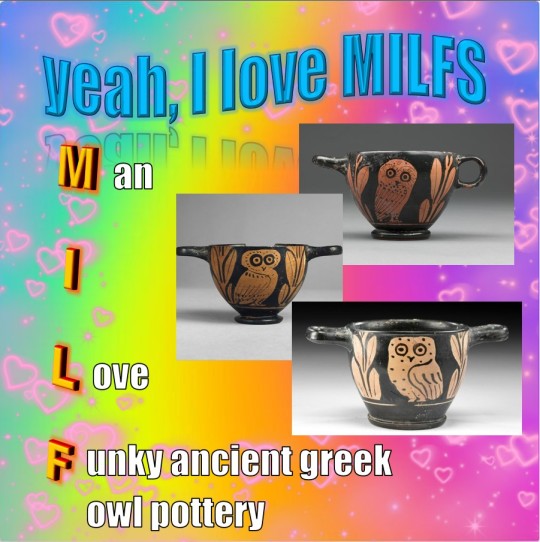
i would die for owl skyphoi
8K notes
·
View notes
Text
new favorite type of ancient artifact: ancient greek skyphoi decorated with owls who look like they've seen unspeakable horrors

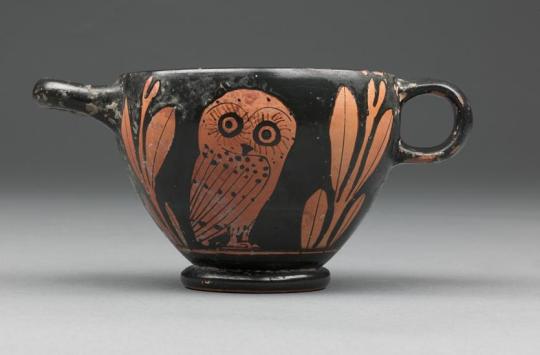


#yeah ive been looking up a lot of ancient owl art lately#if you couldn't tell#owls#tagamemnon#queueusque tandem abutere catilina patientia nostra
13K notes
·
View notes
Text

Doodles of ancient Greek pottery from the geometric period.
the Elgin Amphora, 780-750BC, excavated in Athens
oinochoe, circa 725BC
skyphos, 740-720BC, with a one-bird motif that's typical for skyphoi made in Chalcis
pyxis with four horses, circa 740BC, attributed to the "Painter of London"
pitcher, 760-750BC, made in Attica
507 notes
·
View notes
Text

Tableware from the Tivoli Hoard. Roman mid-1st century BCE. x
This group of silver tableware forms part of a hoard, said to be from Tivoli, near Rome. Tivoli was a popular site for luxury villas in the Late Republic, and was to Rome what Boscoreale and Boscotrecase in the Campanian countryside were to Naples. The Tivoli hoard, comprising thirty pieces in all, includes two decorated skyphoi (wine cups), a ladle, a trulla (spouted pitcher), and several spoons, all of which would have been used at dining and drinking parties. Inscriptions on the pair of drinking cups and the ladle give the weight of each piece and the owner's name: "Sattia, daughter of Lucius." The hoard was probably buried as a result of the civil wars and political unrest in Rome during the last decades of the Republic. The elegant soup spoons in this group give a clue to the diverse courses favored in Roman cuisine; the ample bowl of the ladle, like that of the cups, shows an appreciation of wine. We learn details of Roman cuisine through the cookbook of Apicius and the writings of Petronius, Juvenal, and Martial. The dietary preferences of the Romans were remarkably close to the tastes of modern-day Italians. The gustatio, or first course, consisted of shellfish, eggs, or salad. The cena, or main course, featured a succession of roasted meats. The meal ended with sweetmeats and fruits.
182 notes
·
View notes
Text


Did two quick black and red figure pottery inspired designs b/c I was bored.
The first one is an odyssey inspired design I’m using for a ceramic plaque (I’ve been making Greek pottery for an independent study project).
The second one is this owl design I discovered while looking up Athena pottery examples. I found like three or four pictures of skyphoi with this owl design and I just thought it was really cute 🤧 I have an aryballos with this pattern as well as a mini plaque just for fun.
#art#artist#epic the musical#tagamemnon#Greek mythology#greek myth art#greek pottery#black figure pottery designs#red figure pottery designs#digital art#digital illustration#the odyssey#athena
65 notes
·
View notes
Text
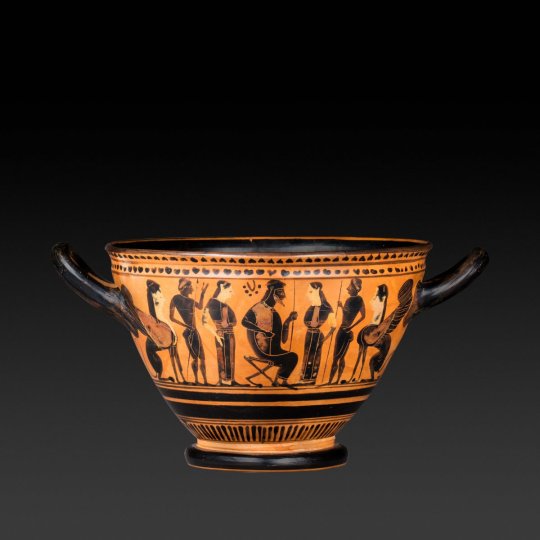
The skyphos is a large ceramic cup used by the ancient Greeks for the consumption of large quantities of wine. At informal male gatherings known as symposia, heady philosophical discussions usually progressed to drunken riotousness as the contents of the skyphoi were replenished.
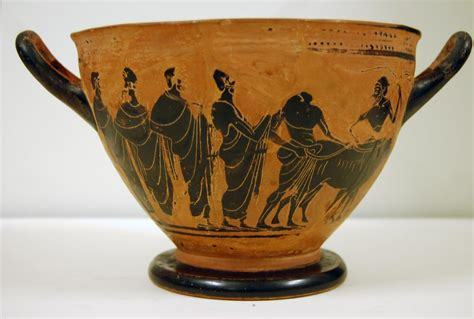
Skyphoi were often decorated with exquisitely painted scenes with clear references to Dionysos, the god of wine and revelry. In cases like the one seen here, however, the decoration evokes a far different relationship with the divine.
The scene on this skyphos represents a parodied depiction of the Judgment of Paris, a well-known incident from The Iliad, Homer’s epic story of the invasion of Troy by the Greeks. The evocation of a world of mysterious, irrational forces on the vase reveals a side of the Greek temperament at odds with the magisterial order imposed on human society by the Olympian gods.
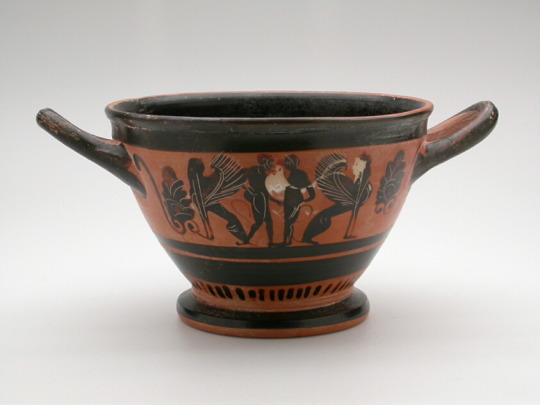
The image of black people plays a key role in the reconciliation between the everyday world of the Greeks and the more intimate experience of spiritual revelation.
The Trojan prince Paris was appointed by Zeus, ruler of the Olympian deities, to step in and settle rival claims of consummate beauty made by the goddesses Hera, Minerva and Aphrodite.
The fateful event is here reduced to only three summarily rendered characters. At left and center, respectively, Hera and Aphrodite are seated on the rocky slopes of Mount Ida, a sacred spot in the northwestern part of modern Turkey. Hera, queen of the gods, prominently wields her scepter, while Aphrodite, goddess of beauty and sensuality, holds the just-presented wreath of victory.
Before them stands Hermes, the winged god of communication and safe passage. In return for favoring Aphrodite, Paris received Helen of Sparta, the loveliest of all mortal women. The struggle by the Greeks to recover the already married Helen lasted 10 years and ended with the total destruction of Troy.
The story of the Judgment of Paris has been told and retold countless times, both in literary versions and in artistic form. Here, however, the straightforward treatment of the event has taken on a radically different form.
The face of Hera leers grotesquely with staring eyes and gaping mouth. Similarly, the representation of Aphrodite departs in a quite unexpected way from the somatic norm of the Greek figure. Rendered in strict profile, her negroid features are clearly evident. The same evocation of blackness characterizes the head of Hermes confronting her own.
All painted wares of this particular type are associated exclusively with the Kabeirion, a sanctuary located several miles outside the Greek city of Thebes. The sacred precinct is named after the kabeiroi, underground deities worshipped in secret. The appeal of this and other ancient mysterious religions such as the Egyptian Isis cult lay in the profound shift from the conventional obeisance to the gods to a rapturous, personal identification with the divine by initiates to the cult.
The numerous drinking vessels found at the Kabeirion seem to have formed an integral part of the rituals held at the sanctuary. The rites apparently concluded with the smashing of the cups, perhaps as a way of invoking the power of the kabeiroi.
The painted scene on the skyphos could also recall a dramatic presentation of the event, perhaps a short play staged in honor of the local deities. In this case, actors such as those portraying Aphrodite and Hermes on the cup would presumably have appeared as Africans, their affect aided by carved and painted theatrical masks.
The same inclusion of blackness holds true for several other types of scenes found on the Kabeirion skyphoi. One of the most remarkable of these presents a dramatic confrontation taken from Homer’s Odyssey, the companion epic to The Iliad.
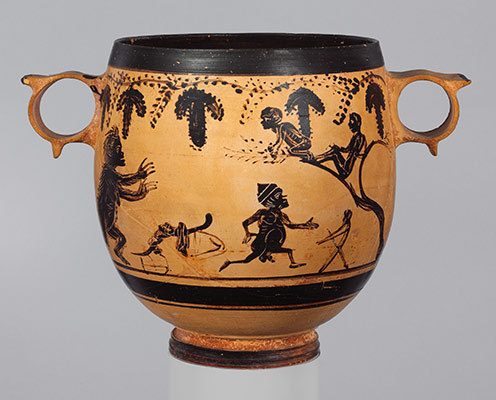
During a stop along the wandering path of his journey home, the great hero Odysseus encounters the sorceress Circe, who tries to transform him into a pig in order to keep him with her. She offers him the fateful potion, which he rejects with a surprised gesture. Circe appears unmistakably as a black woman, while Odysseus’ image is in keeping with the standard type of the old man in Greek art.
The underlying emphasis on powerful, occult forces in the Circe scene made it an ideal subject for use at the Kabeirion. The moment of potential metamorphosis from a rational creature into another, less comprehending form alludes to the ecstatic experience undergone by the initiates of the cult. Interestingly, the notion of a black Circe as skilled practitioner of spells reappears in our own time as the protagonist in Toni Morrison’s Song of Solomon.
The visual characterization of blacks as figures from Greek legend seems to have been derived from the association of Africans with the liminal zones of the earth, associated by the Greeks with barbarism—simply meaning non-Greek culture. On other skyphoi, the range of black figures includes the highly popular type of the cave-dwelling pygmy.
The great appeal of such foreign cultures for the Greeks stems, at least in part, from the belief that imagery derived from the African physiognomy could effectively counter the powerful, unsettling forces at large in the world.
As in any society, the farther a given form departed from Greek norms, the more unsettling it seemed. This response was hardly demeaning, however, since for the Greeks the exotic in nature held an enormous capacity for warding off evil. The apotropaic effect was greatly enhanced by the caricatural treatment of the subject, as seen in the representation of Aphrodite and Hermes on this skyphos.
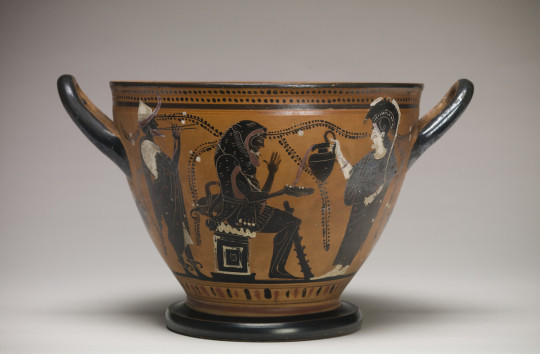
The apparently mocking treatment of the black figures in the Judgment of Paris should be regarded as a calculated inversion of the usual relationship between the Greeks and their gods. At a site where the powerful and potentially dangerous Kabeiric mysteries were summoned, the normal place of Greek religion was given over to the protection of the site’s resident forces.
The rendering of the Olympian gods as a positive form of the racialized other is supported in the extensive modern literature on the subject. Such a view is borne out by the argument of the pioneering scholar Frank Snowden that true racial prejudice did not exist in ancient times but evolved only with the advent of the slave trade in the early-modern period.
Snowden’s view is further supported by the incredible variety of sympathetic guises taken by the black form in ancient Greek and Roman art.
The profile features of a black man appear on coins minted by the city of Delphi in apparent homage to the venerated founder of the city. Among the Etruscans, the masklike black face placed on the eaves of a sacred shrine served as a powerful means to repel evil forces, a quality incidentally attributed to the kabeiroi themselves.
#Why Greek Goddesses Appear as Black Women on an Ancient Ceramic Cup#Black History#greecian lies#white lies
6 notes
·
View notes
Text
Zeus Lykaios

In the heart of ancient Arkadia, atop Mt Lykaion, was an enormous ash altar dedicated to the prehistoric sky-god form of Zeus. In effigies discovered in excavations of the ashen mound, he is referred to by his oldest epithet, Zeus Semios, the Giver of Signs, among others; Zeus Ombrios, the Showery; Zeus Lykaios, interpreted alternately as both Zeus the Wolf-like and Zeus the Light. This site was three-layered: the top of the mountain was devoted to burnt offerings; the second, about halfway down the mountain, was the larger sanctuary that attracted the most visitors. It is assumed that this first sanctuary was what the majority of traveling worshippers came to see and leave offerings at the second altar. This was devoted to rites of thanksgiving, praying, and leaving smaller personal offerings that would not be taken to the mountaintop. Halfway between the two sanctuaries was a fountain, a spring of freshwater where Pausanias recorded witnessing priests coming together to officiate a ritual to entreat Zeus into letting down rain.
Offerings:
Most of the people coming to this specific sanctuary in Arkadia were farmers from the surrounding land. Their requests were most often recorded as prayers for rain and plentiful harvests. They offered many things, including livestock to be sacrificed and their bones burnt on the peak altar, but this was not the norm. Many household objects have been unearthed, but here are some notable surviving offerings to Zeus:
Philai (small libation bowls)
Skyphoi (a deep wine bowl with two handles and a stand)
Terracotta lamps
Iron knives
Bronze rings
Iron keys
Terracotta figurine of a small bird
Coins
Miniature bronze tripod cauldrons
depictions of Zeus
In modern reconstruction, offerings of jewelry, pottery, statues, coins, and figurines are historically attested.
#arkadia#arkadian reconstruction#arkadian reconstructionism#hellenism#hellenic gods#zeus#zeus worship#hellenic reconstructionism#hellenic polytheism#hellenic polytheist#hellenic paganism#hellenic worship#zeus devotion#hellenic community
94 notes
·
View notes
Note
so i modded the shit out of fallout 4 to make it look good and i'm about to start new vegas, are there any good mods to improve the visuals in nv that you'd recommend before i start it? :o
yES here they are babe:
nmc’s texture pack for new vegas / ojo bueno
nevada skies / realistic wasteland lighting
dynamic weather
dk female face textures / zzjays body and face textures
interior lighting overhaul
eve -- essential visual enhancements
wasteland flora overhaul
enhanced blood textures
electro-city relighting
enbs are whatever you prefer but i personally use nevada and have used dynamo, oxide, onix, and chromatic melancholy
realistic headshots
landscape overhaul
mojave sandy desert
7 notes
·
View notes
Text
skyphoi replied to your post: [[MOR] when you finally motivate yourself to...
relatable i’m applying for jobs rn too
ahhh good luck! let's both try our best~
2 notes
·
View notes
Photo
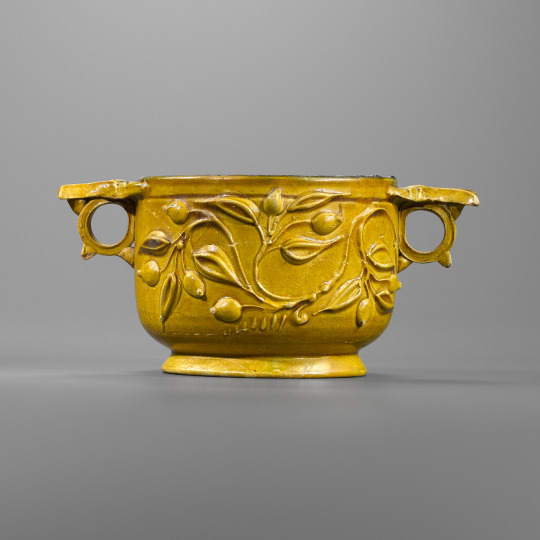
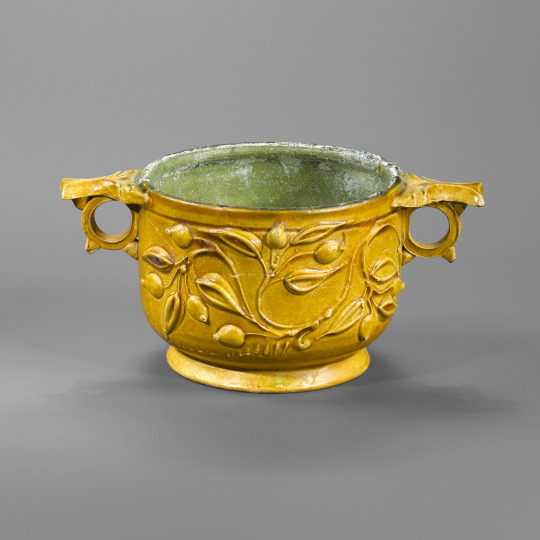
Roman Faience Skyphos with a Pomegranate Branch in Relief
Roman · 1st century A.D.
The skyphos has a high cylindrical body with a straight wall, supported by a small circular foot, which was probably modeled separately and attached before firing. The two ring-shaped handles are surmounted by a horizontal thumb-piece that forms a kind of extension of the lip; it facilitates and stabilizes the handling of the vessel.
The decoration in relief (probably made using the technique of terra sigillata) includes a single repeating motif on both faces: a long sinuous branch with pointed leaves and circular fruits, in which archaeologists recognize either small pomegranates or myrtle berries. As on many vessels made of precious metal, of which this skyphos is a beautiful imitation, the use of plant branches for decoration is not rare; among the plants most frequently represented are the olive, the wild grape, and the oak. A symbolic meaning is often sought to explain them: the pomegranate, the fruit of Aphrodite, was a symbol of fertility; the myrtle, which served for the crown of a bride, was not only linked to marriage and fecundity, but was also given to underground deities and deposited in tombs during burial rites. The presence of these plants, however, might have simply been a response to an aesthetic problem, especially since these flora were so widespread in the Mediterranean world. Skyphoi are among the most documented forms of glazed terra-cotta in the workshops of Asia Minor.
Thanks to its excellent state of preservation and its fine technical and artistic qualities, this piece is an outstanding example. According to the classification of A. Hochuli-Gysel, it belongs to skyphoi of type 1acharacterized by the rounded and more slender outline of the lower partand would be a production of a micro-Asiatic workshop based, perhaps, in Tarsus. It can be dated to the early imperial period. The ancient Near Eastern technique of adding leaded glaze to a previously fired terra-cotta vessel was adopted by several workshops in Asia Minor toward the end of the Hellenistic period. The process required a second firing to fix the glaze. This method was certainly used since it allowed a better imitation of vessels in precious metal than did the usual black figure pottery; among the most commonly attested forms, most were borrowed from the repertory of metalworking, for example, the skyphos, oinochoe, or kantharos. In the early imperial period, the competition of glass, an easy-to-work material and available everywhere, and easily reusable, prevented glazed pottery from achieving great commercial success, despite qualitatively good results and widespread distribution.
#Roman Faience Skyphos with a Pomegranate Branch in Relief#Roman · 1st century A.D.#art#artist#art work#art news#ancient art#glass#history#history news#ancient history#ancient culture#ancient civilizations#archeology#archeolgst
34 notes
·
View notes
Quote
The Great Magical Papyrus in Paris contains a series of four recipes for magical operations with a human skull ascribed to the Thessalian king Pitys. Here is the opening of the second recipe: ‘Attracton spell of Pitys. Pitys sends greetings to king Ostanes. Since you repeatedly write to me about the inquiry into skull-cups (skyphoi), I thought I should send you this technique. It is to be treasured, and it has the potential to please you greatly. Take an ass’s skin, dry it in the shade and draw upon it the figure that will be revealed and the following text, in a circle: ‘AAMASI NOUTHI APHTHECHEMBOCH… I conjure you, demon of a dead man, by the strong and implacable god and by his holy names, to stand yourself at my side in the coming night, in the form you used to have, and tell me whether you are able to perform the task in question. Now, now, quickly, quickly!’ Then go swiftly to a place where there is a burial, or where something has been disposed of, if you do not have a burial. Spread the hide underneath at sunset. Go back home and he will by all means come to you and stand himself by you on that night. He reports to you the manner of his death and first he will tell you whether he has the strength to do anything or undertake any service for you… He attracts people, he lays them down on a sickbed, he sends dreams, he restrains and he procures revelations in dreams too. This spell alone can do all these things. Just modify the commonplaces in accordance with your project. Most of the mages, who carried their equipment with them, laid it aside and used him for an assistant. They accomplished the things laid out above with all speed. For the technique is without all those needless extra words, but it completes the things laid out above quickly and with all ease…’
One is, in other words, to take a human skull from a grave or from wherever one can find one, and lay it out on a hide that has been prepared from the skin of an ass and inscribed with a magical figure and a magical formula. This formula invokes the ghost of a dead man, presumably the former owner of the skull, to manifest himself to the practitioner during the night in the form of a dream. The ghost will tell the practitioner how he died. This is in any case ancient ghosts’ favorite topic of conversation, unsurprisingly, because the primary raison d’etre of the ancient ghost was to function as an indicator of the problematic circumstances surrounding a death or burial. The ghost then goes on to explain whether he has the strength to act as an assistant demon or ‘familiar’ to the practitioner. It is possible that his degree of strength depends on, and is correlated to, his degree of restlessness. If he does have the strength to act as an assistant, then he will be able, apparently, to perform any task or function the mages of yore or their latter-day counterparts might require, but the function of erotic attraction, the infliction of illness, dream-sending and binding magic are singled out for mention.
Daniel Ogden - Night’s Black Agents: Witches, Wizards and the Dead in the Ancient World
10 notes
·
View notes
Text
My favourite thing about the pendent semicircle (PSC) skyphoi are when the PSC are placed juuust far enough apart to look like a pair of eyes
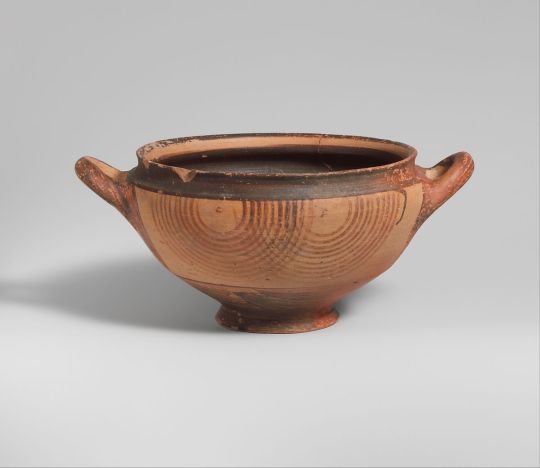
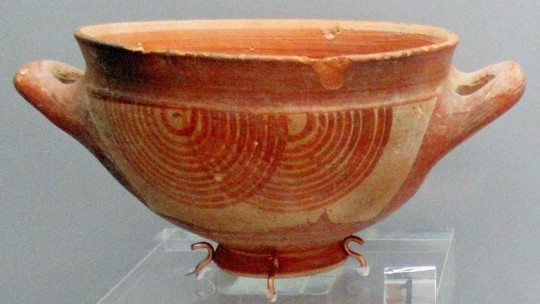

Look at these highly confused but very polite little gentlemen! Delightful
#greek pottery#euboea#tagammemnon#ancient Greece#vases#protogeometric#archaeology#classical archaeology
6 notes
·
View notes
